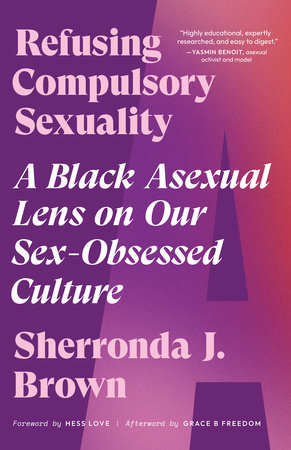Ace Week / Jackson
Press Release – Jackson
Jackson- Brown, Refusing Compulsory Sexuality
On Decolonizing Sexuality: How Sherronda Brown’s Refusing Compulsory Sexuality Deconstructs Sexuality Through a Black Asexual Lens

Historiography Connections
Ethnohistory, Social History, Cultural History, Gender History, Economic History
Geographic Coverage
United States
Citation for First Edition/Printing
Sherronda J. Brown, Refusing Compulsory Sexuality: A Black Asexual Lens on Our Sex-Obsessed Culture (California: North Atlantic Books, 2022)
Press Release
Sherronda J. Brown, is an essayist, editor, storyteller, creative consultant, artist, and author, who currently serves as the editor-in-chief for Scalawag Magazine. They write extensively on queer theory and asexuality, and often engages in cultural critique and media analysis with a particular focus on the horror genre. [1] Refusing Compulsory Sexuality was created when the publisher reached out to Brown and requested that they write about Black asexuality, based on some of their previous writing about the subject. They wanted to contribute to the wider conversation about sexual politics as a whole, rather than confining their scope to solely talking about the “Black asexual experience,” so they conducted research relating to asexuality and the politics of gender and race and interviewed other Black asexual people, and published this book as a way to move the cultural conversation about asexuality beyond introductory terms of previous works. [2]
Content
The book is divided into twelve chapters that explore different aspects of how sex is viewed in society, and dives into how understanding asexuality, especially as it relates to Black asexuals, breaks the various different structures that society has normalized. There are topics ranging from general acephobia and gatekeeping within the queer community, to discussions of sex as it relates to our perceptions of adulthood and productivity, to conversations about how different types of Black people are sexualized and desexualized based on the negative stereotypes associated with their bodies, to threading as much of the documented history of discussion about asexuality as Brown could find from 1855 to 2021 and shedding light on what the future could potentially look like if society were to fully accept the possibility of the Black asexual.
Methods
Brown makes a cultural analysis of compulsory (hetero)sexuality and applies a Black asexual lens to it. [2] Through critiquing compulsory sexuality through this lens, they analyze how the existence of the Black asexual challenges both society’s understanding of what it means to be a man or woman, and what it means to be a white or Black person. They also create a framework that understands Black asexuality as a challenge to the social, economic, and cultural structures that society created to uphold white supremacist ideals.
Critiques
Many historians, straight and queer alike, have a tendency to ignore or actively exclude asexual people from the historical canon. Of the few people that have studied asexuality, very few concentrate on non-white asexuals. As such, they run the risk of upholding white supremacy in their analysis of queerness in general and of asexuality specifically. It is also worth considering that Brown is not a historian by trade, and some may be inclined to dismiss their work because they specifically aren’t a historian. They do however, have a background in journalism and show great strength in researching asexuality in history and wider culture and bringing a new analysis to the cultural conversation around asexuality that has not been seen prior to the release of their book.
Impacts on Historiography
This book, along with books like Ace by Angela Chen, are part of a new wave of literature within the asexual cannon that has helped move the conversation about asexuality outside of the realm of “Asexuality 101/Introduction to Asexuality” work that had been done by past authors. While the introduction of asexuality to a wider audience remains necessary in the face of under recognition amongst both heterosexual people and queer people, it is important to be able to have deeper conversations about what asexuality has to say about the wider culture and how asexuality can challenge everything that we as a society have learned about each other as humans. It is especially worth noting the impact that this book in particular has had on Black asexuals and their understanding of their own sexuality, and how this book has helped Black asexuals recognize how they fit within the wider asexual liberation movement.
[1] Scalawag. “Sherronda J. Brown, Scalawag Editors, Author at Scalawag,” August 26, 2024. http://scalawagmagazine.org/author/sherrondajbrown/.
[2] Owagboriaye, Ashabi (@_aceingrace_). 2023. “I had the pleasure of picking the brain of @sherrondajbrown, author of Refusing Compulsory Sexuality to hear more about their thoughts on how this book came to be and other topics that revolve around Blackness and Asexuality.” Instagram, February 25, 2023. https://www.instagram.com/_aceingrace_/p/CpGh94pPgDX/?img_index=2
[3] Brown, Sherronda J. Refusing Compulsory Sexuality: A Black Asexual Lens on Our Sex-Obsessed Culture. North Atlantic Books, 2022.
